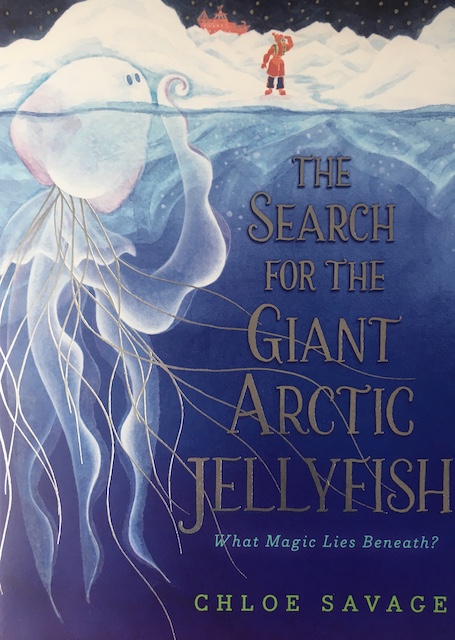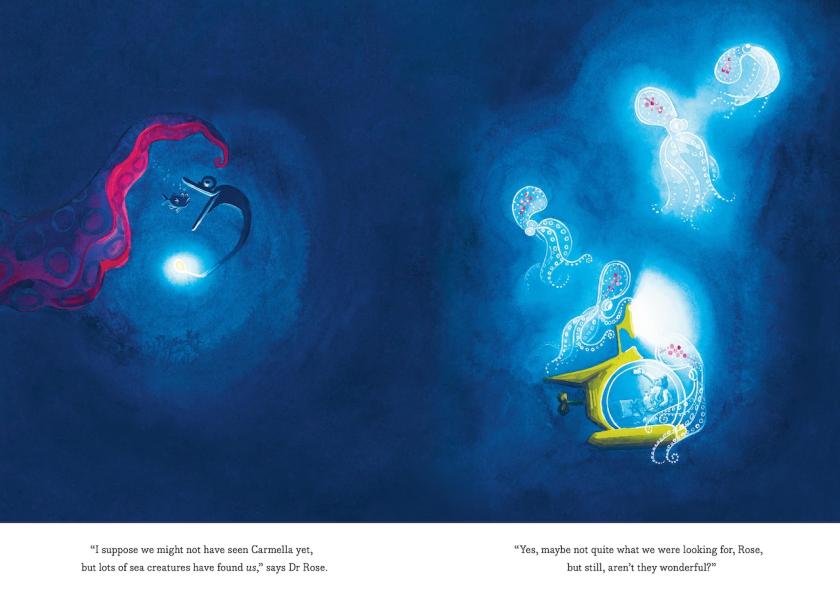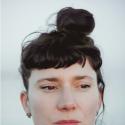How old were you when you first had an image of the Arctic? When you first had that image, what was it that most resonated? Was it its remoteness, the endless snow and ice, the polar bears? Did it seem like a mythical place of mirages and monsters? Or was it a place you thought you might travel to or even work one day?
For young readers of the beguiling, illustrated books by fast rising children’s author Chloe Savage, there’s a chance to encounter the Arctic both as a place of magic and as a fascinating scientific proposition. In The Search for the Giant Arctic Jellyfish – which won the Illustrated Books category at this year’s Waterstones Children’s Book Prize – she introduces us to the female scientist, Dr Morley, who has been fascinated her entire life by the creature of the title. On the very first page there is a beautiful map with handwritten names that shows the North Pole right at the centre of a region that includes Europe and North America. On the title page there is a meticulously detailed inventory of all the clothes and gear that Dr Morley will be taking ranging from woolly hats to walkie talkies.
Though there’s no shortage of children’s authors inspired by the Arctic – whether it’s Philip Pullman in His Dark Materials or Hannah Gold in The Last Bear – few give such a good idea of what might be needed to go there in practical terms. Before meeting Chloe Savage, I have developed the theory that she’s determined to create a new generation of marine scientists (her second book The Search for Carmella takes readers to the bottom of the ocean) but the reality is of course more subtle than that. “I’m part of the Dorling Kindersley generation,” she declares when we meet at the Delaunay on the Aldwych. “I loved books like A Street Through Time [which shows the same “street” from the Stone Age through Vikings, the Middle Ages, the Victorian era and up to the modern day]. But I hated it if any of the illustrations didn’t make sense – so if, for instance, there were pipes that didn’t connect, it would drive me mad. The need to have accurate detail is really strong for me.”
What she has created is no pedant’s portfolio – rather, this attention to detail allows for considerable originality and humour. This is, for instance, one of the rare illustrated Arctic books that only fleetingly features a polar bear. In her decision to focus on the ocean, Savage allows encounters with other equally important species in the Arctic’s ecosystem. For instance, Dr Morley sights a pod of narwhals (brilliantly, when I look it up, I discover the alternative collective noun is “a blessing”) as well as beluga whales. Her crew members see the Northern Lights, draw up meticulous charts from their research and dangle off the side of the ship next to icebergs.

This, in many ways, is the key to what makes Savage’s books seem like such instant classics. Like all the best children’s books, they’re nothing to do with didacticism, but about provoking a sense of wonder and curiosity. We are living at a time when it’s important for all of us to be thinking about what’s happening in the Arctic, which is warming nearly four times faster than the rest of the world. As global corporations plot new shipping routes and different countries investigate mining and oil extraction rights, organisations like the World Wildlife Fund and 90 North Foundation (which is campaigning to create a North Pole Marine Reserve) are working hard to make sure that as adults we are focused on the rich and important biodiversity of the Arctic Ocean.
Yet for children – and indeed the parents who read Savage’s book with them – that awareness will be instilled through the power of enchantment. She has chosen not to raise issues of global warming, though she knows that “teachers have used my book as a tool to say these are the animals that live there, and what affects them will affect you. However, what I want is to create something that incites children’s interest in the world around them, so they can seek it out and learn to value it.”
The Arctic is of course an artist’s dream with the refractions of light from snow and ice, the sublime grandeur of its icebergs and glaciers and the extraordinary qualities of the animals who survive there. Savage, who has not travelled to the Arctic yet, admits that she came up with the idea “in a North London warehouse where it was bitterly cold. So I started thinking about the Arctic and how exciting and beautiful it was. I enjoy the fluidity and physicality of painting big landscapes. I use thick paper, so I use many layers of paint – acrylic based for the ice, then lots of layers of blue watercolour on top for the sea.”
In her second book, The Search for Carmella, another female marine scientist – Dr Rose – teams up with a brilliant submersible pilot, Anne, who takes her to the very bottom of the ocean. This, of course, presents a different set of challenges, not least in the massive reduction of the light spectrum. The articulate and elegant Savage who has arrived for our interview dressed in deep reddish pink, the same colour – as she points out – as the mythical beast Carmella, says she was drawn to this particular idea because of the opportunity it presented to explore bioluminescence.
 There is a sense of rich colour in this book too – the Leonardo da Vinci-inspired submersible is a canary yellow, and there are dancing pink crabs and a multitude of flamingos at the surface. Yet the deeper Dr Rose goes, the more ghostly and surreal the creatures become. As with the ice and snow in the Arctic, you can sense Savage revelling in the different aspects of whiteness, creating a translucent magical world that teeters on the brink of the real and the mythical. Carmella herself who – spoiler alert, remains tantalisingly invisible to Dr Rose – is red because this has the lowest frequency in the spectrum, which means it’s the hardest colour to see in the dark.
There is a sense of rich colour in this book too – the Leonardo da Vinci-inspired submersible is a canary yellow, and there are dancing pink crabs and a multitude of flamingos at the surface. Yet the deeper Dr Rose goes, the more ghostly and surreal the creatures become. As with the ice and snow in the Arctic, you can sense Savage revelling in the different aspects of whiteness, creating a translucent magical world that teeters on the brink of the real and the mythical. Carmella herself who – spoiler alert, remains tantalisingly invisible to Dr Rose – is red because this has the lowest frequency in the spectrum, which means it’s the hardest colour to see in the dark.
Where does she want to take her readers in her third book? “My next book will be set in space,” she replies. “My main character will be Commander Julia.” She has just submitted the manuscript but for now she won’t be drawn any further on the detail. What seems certain is that young readers who travel to space through Savage’s eyes – just as those who have dived the ocean with her – will be every bit as gripped by the delicious detail of preparing for the journey as by the everyday miracles that will be revealed when they get there.
Chloe Savage is published by Walker Books.















Add comment